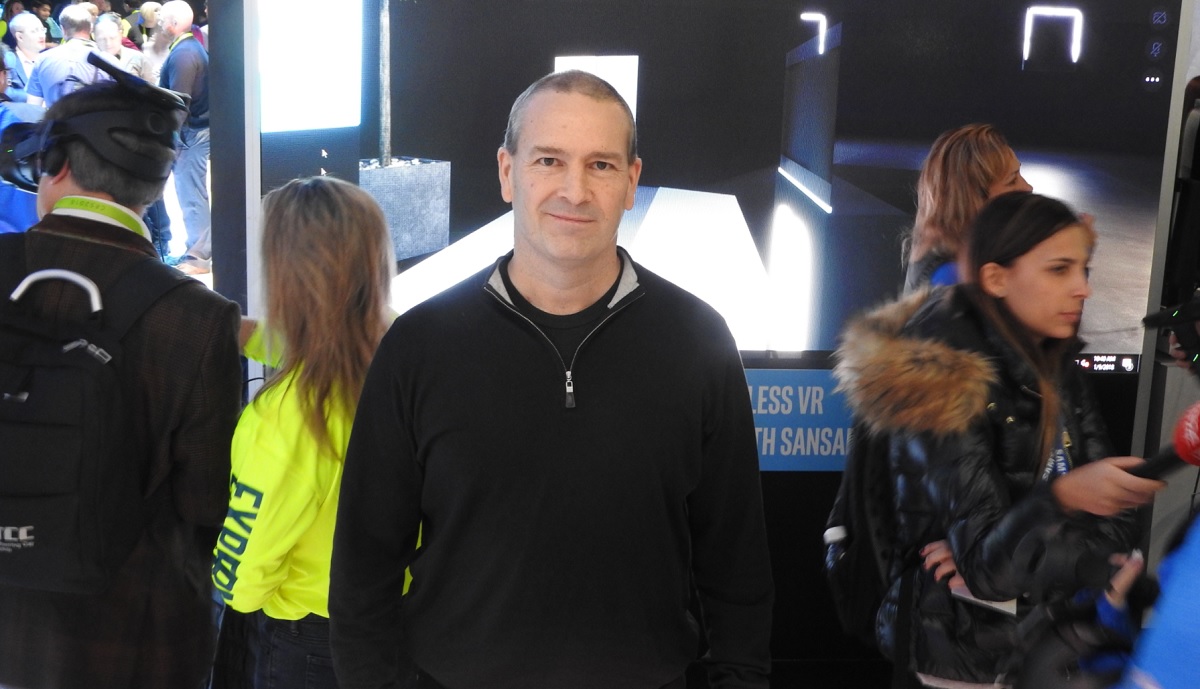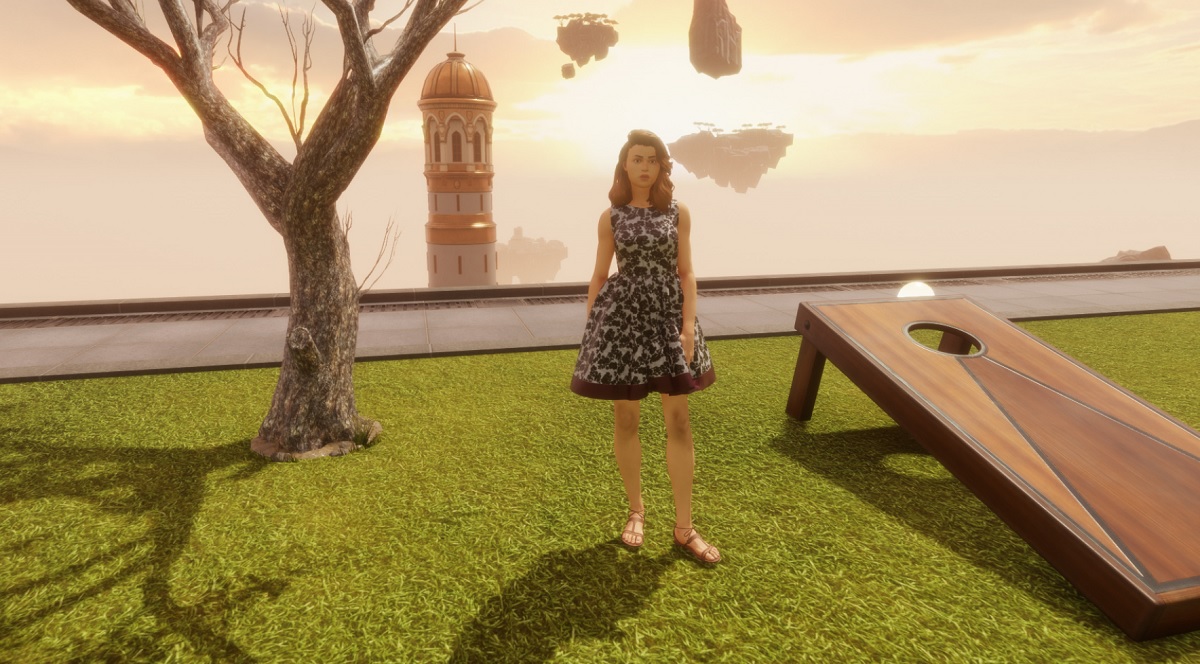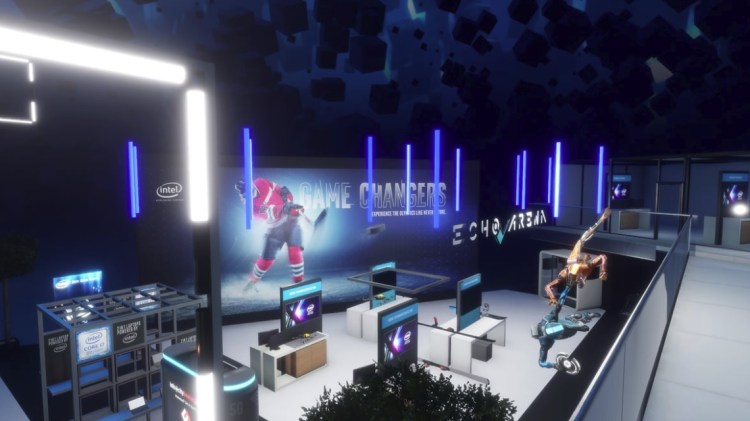Linden Lab makes a lot of money with the sale of virtual goods in its Second Life virtual world. But this year, it is adding Sansar, a collection of virtual reality spaces where users can create their own immersive experiences inside their own VR scenes.
Intel CEO Brian Krzanich put Sansar in the spotlight during his opening keynote speech at the 2018 Consumer Electronics Show (CES), the big tech trade show in Las Vegas last week. Intel took two-and-a-half months to build a replica of the Intel CES booth inside a Sansar scene. I went inside and cruised around the booth, which was pretty realistic. The avatars of the people were kind of clunky, but that didn’t bother me much.
Ebbe Altberg, CEO of Linden Lab, was at the real Intel booth this week in a kind of meta experience, as he was talking about the Intel booth in VR inside Sansar. I went through the experience and interviewed him about what both individuals and companies can build inside Sansar.
Intel had plenty of room to build because you can build a VR experience that spans four kilometers by four kilometers in a virtual space, Altberg said. You can add fashion twists on the avatars by buying clothes in Sansar or creating your own.
Here’s an edited transcript of our interview.

Above: Linden Lab CEO Ebbe Altberg at the Intel booth at CES 2018.
GamesBeat: The areas you were talking about, does that translate into some amount of square footage of virtual space?
Ebbe Altberg: We wanted to make sure that we don’t create a lot of friction in the ability to create and share a tremendous amount of interesting content. A virtual experience — what we call a scene, which is the building block, compared to a region in Second Life — in Sansar it can be up to four kilometers by four kilometers. A region in Second Life is 256 meters by 256 meters. You can create huge experiences.
There are a lot of other differences. In Second Life, all the regions run hot, 24/7, whether someone is visiting or not. The server costs are high. In Sansar, when everyone leaves a scene, if no one’s visiting, we can park it on disc, and when someone comes to visit, we spin it up fast for people to get into it. Only the areas that are being visited are actually using compute power.
In Sansar, we also support instanced scenes. When an experience fills up, we can just launch additional instances, which means that if you create an interesting game on the platform, something like that, you can have an infinite amount of demand to experience it with no problem, just like any game would. You don’t have to have 100,000 people in a single instance of Halo. Computing would be really difficult if you wanted to make that performant. We can have a cutoff where we say, “OK, that’s enough people in that scene, now spawn a new one.” That makes it more interesting to certain creators because they know they can reach a really large audience with the content they create.

Above: Sansar Autowerks.
GamesBeat: Intel said it took two-and-a-half months to build this. Did you have to work closely with them?
Altberg: Our internal studio made the content in collaboration with Intel. They made this whole show floor, a near-perfect replica. The architect that built this stage, he had never seen the space, so we helped him take a look at it as it was being built. He was really floored by the amount of detail. He’s hoping to take his clients through here. When he came out of the experience, he pulled up a render on his PC, a 2D render, and he leans into his computer. I said, “Did you just try to walk into your computer?” He said, “I totally did!”
There are different types of use cases, whether it’s education, architecture, design, gaming, and role-playing. There are so many ways to do this. Today, it’s really fairly technically complex to create something like this. You have to work with Unity or Unreal. Only a few specialized studios have their own engines. Then, you have to have an engineering team to build a back end, an avatar system, a monetization system, a social communication system. That’s heavy lifting. We provide all of it, so people can just focus on building the content, and people can instantly come into it and have social interactions with each other and with the content.
Aech’s Garage, have you been in there? You have to check that out. We worked with Warner Bros. and Steven Spielberg gave us the thumbs up. He came in and checked it out. I know the author of Ready Player One has been in there as well. He was really psyched about it. He had some cool ideas for how to take it further. We also built the inside of the i8 processor, so you can walk inside of the chip. All of that content was built in seven or eight weeks.
GamesBeat: Is this one of your biggest events at this point?
Altberg: We’re still pretty early. We’re still in what we call creator beta. We’ve been very focused on getting the tool set, building the engine, building the cloud infrastructure to make it possible for this content to be created. This year, we’ll be focusing more and more on the consumer experience. How do you find content? How do you find friends? Working more on the engagement and retention of consumers. That’s a big project. We’ll come out of beta probably sometime later this year, but it’s still early.
GamesBeat: It seems like you still have the same opportunity, though, to get a lot of the IBMs of the world interested.

Above: Sansar lets you design virtual fashion with Clo’s fashion design software.
Altberg: Second Life, early on, had a lot of traction with brands and corporations. We still, today, have a huge number of universities and students learning all kinds of subject matter inside Second Life. We’re going to do a tour on stage here at 10:15 with Raja from Intel, talking about business development on the education side. We’ll be walking through some Sansar experiences. We’ll go to Egypt, to the moon, some other places.
GamesBeat: How is overall traffic at Sansar?
Altberg: It’s still low. We haven’t spent a dime trying to acquire users. We’ve just been focused on working with creators to make sure they have the tools. Already, we have thousands of experiences being created on the platform. Close to a thousand of them are in our atlas, in the directory. Many are private as well, so you can’t find them. They’re only available to the creator and whoever they want to give access to. There’s both private and public access areas. We’ve been working exclusively with creators to make sure they can create high fidelity content. Being able to create all this content in less than two months, it would have been impossible with any other platform.
GamesBeat: I talked to Phil Rosedale (founder of Linden Lab, now at High Fidelity) about blockchain opportunities. Do you guys see the same potential as far as making portable avatars, things like that?
Altberg: Portable avatars I’m not sure about. Portable merchandise, even then you’re getting into — I don’t know. We’ll see how that plays out. We have a lot of experience with marketplaces. The Second Life marketplace still represents $500 million worth of business. Last year, users in Second Life cashed out about $60 million in money they made creating content and services on the platform. Blockchain is one way to keep track of who owns what. We have our own stuff that already does all that, though.

Above: Intel showed off the Sansar virtual world tech at its CES 2018 keynote speech.
GamesBeat: The idea seems to be that you can make some of these worlds interoperable.
Altberg: The interoperability issue — I mean, blockchain might be a piece of that puzzle, but you have to think of other standards as well. Imagining your avatar just being able to walk across to another platform and have the animations and rendering and facial expression technologies, all this special sauce we all build, having that work across platforms, you’d end up having to deal with some kind of lowest common denominator for how that would work.
There’s still so much evolution in these technologies. Coming up with a standard now — just think about identity. Do we have a universal identity system on planet Earth? No. And that’s just usernames and passwords. Never mind your appearance, your functionality, all that stuff. Suddenly, that’s going to go across? It’s one of those problems that just makes my head hurt. It would be fascinating, but it would be really difficult to do.
You tend to see that successful, large-scale networks are more vertical like Facebook or Instagram. Getting something that’s horizontal, across organizations, where they all agree on business models and technologies, that’s really complicated.
GamesBeat: What other things could a corporation do with a Sansar experience?
Altberg: From the things we’ve seen in Second Life, we already know that there are huge opportunities in education and in training. You’re already seeing Wal-Mart training people in how to do customer service. I talked to a good friend of mine last night who created a training system for using a forklift. Education, training, branding, sales. Virtually walking into a store and being able to look at a couch, click a button, and have it delivered to your house.
In December, we launched a fashion-industry experience. Users are creating thousands of virtual items. You can see a connection there someday with the physical world. “I like that jacket. Can you ship one of those to my house?” Almost everything we do in physical space, we’ll also be able to do in virtual space. I see it as a replacement or an extension for a lot of things we do normally in everyday life, in the physical space. You and I could have this conversation in a virtual space, and it really wouldn’t be any different.
You can’t eat, drink, or procreate in a virtual space, but otherwise — there are a lot of things you can do in a virtual space that you can’t do in physical space. I can go to the moon. I can go to a tomb in Egypt. I can experience things that are otherwise impossible. It’s going to extend [to] almost everything we do.

Above: Thomas Tang of Xiaomi and the Mi Ecosystem announces a new VR device.
GamesBeat: I noticed that VR at this show is down as far as the number of booths. There’s a weeding-out happening, maybe.
Altberg: It’s early days. You always have that overreaction, everyone piling on, and then, they realize that it’ll take a while for the market to mature. Sansar you can run straight up on the PC or in VR. You don’t have to have VR equipment to access all this stuff and create content, although it’s more fun to go into the world.
It’ll take years, I think, for virtual reality — the hardware, the price, the resolution, the field of view, the weight, the wires, the compute power. I think of it as like the phone industry. Where was any of this in the ‘90s? How clunky were these in the ‘90s? This thing came out just a decade ago, two decades after mobile phones started. It’ll take a while. But it’s only going to grow.


